Geochemical Considerations from the Carboniferous Unconventional Petroleum System of SW Iberia
Abstract
:1. Introduction
Geological Framework
2. Materials and Methods
2.1. TOC and Rock–Eval Pyrolysis
2.2. Vitrinite Reflectance Analysis (VR)
3. Results
3.1. Total Organic Carbon
3.2. Rock–Eval Pyrolysis Parameters
3.3. Organic Petrographic Analysis
4. Discussion
4.1. Organic Carbon Loss
4.2. Thermal Maturation and Low-Grade Metamorphic Zones
4.3. Hydrocarbon Fluids
5. Conclusions
Author Contributions
Funding
Data Availability Statement
Acknowledgments
Conflicts of Interest
References
- Boyer, C.; Clark, B.; Jochen, V.; Lewis, R.; Miller, C.K. Shale Gas: A Global Resource. OilField Rev. 2011, 23, 28–39. [Google Scholar]
- Law, B.E.; Curtis, J.B. Introduction to Unconventional Petroleum Systems. Am. Assoc. Pet. Geol. Bull. 2002, 86, 1851–1852. [Google Scholar] [CrossRef]
- Holditch, S.; Perry, K.; Lee, J. Unconventional Gas Reservoirs: Tight Gas, Coal Seams, and Shales; Technical report for the NPC Global Oil and Gas Study: Washington, DC, USA, July 2007; p. 14. [Google Scholar]
- Ground Water Protection Council and All Consulting. Modern Shale Gas Development in the United States: A Primer. Washington, DC, US Department of Energy Office and Fossil Energy and National Energy Technology Laboratory. 2009. Available online: https://www.energy.gov/fe/downloads/modern-shale-gas-development-united-states-primer (accessed on 25 June 2020).
- Carvalho, D.; Correia, H.; Inverno, C. Contribuição para o conhecimento geológico do Grupo de Ferreira-Ficalho. Suas relações com a Faixa Piritosa e o Grupo do Pulo do Lobo. Mem. Not. Coimbra 1976, 82, 145–169. (In Portuguese) [Google Scholar]
- Fonseca, P.E.; Pimentel, N.; Pena dos Reis, R.; Barberes, G.A. Carboniferous Black-Sahles and Shale-Gas Potential in Southwestern Portugal. Post-Conference Field-trip. In Proceedings of the AAPG—Europe Region Annual Conference & Exhibition, Lisbon, Portugal, 20–21 May 2015. [Google Scholar]
- Oliveira, J.T. The marine Carboniferous of South Portugal: A stratigraphic and sedimentological approach. In The Carboniferous of Portugal; Lemos de Sousa, M.J., Oliveira, J.T., Eds.; Mem. Serv. Geol.: Lisbon, Portugal, 1983; Volume 29, pp. 3–37. [Google Scholar]
- Abad, I.; Mata, M.P.; Nieto, F.; Velilla, N. The Phyllosilicates in diagenetic-metamorphic rocks of the South Portuguese Zone, southwestern Portugal. Can. Mineral. 2001, 39, 1571–1589. [Google Scholar] [CrossRef] [Green Version]
- McCormack, N.; Clayton, G.; Fernandes, P. The thermal history of the Upper Palaeozoic rocks of southern Portugal. Mar. Pet. Geol. 2007, 24, 145–150. [Google Scholar] [CrossRef]
- Fernandes, P.; Musgrave, J.A.; Clayton, G.; Pereira, Z.; Oliveira, J.T.; Goodhue, R.; Rodrigues, B. New evidence concerning the thermal history of Devonian and Carboniferous rocks in the South Portuguese Zone. J. Geol. Soc. Lond. 2012, 169, 647–654. [Google Scholar] [CrossRef] [Green Version]
- Fonseca, P.; Ribeiro, A. Tectonics of Beja-Acebuches Ophiolite: A major suture in the Iberian Variscan Foldbelt. Geol. Rundsch. Springer 1993, 82, 440–447. [Google Scholar] [CrossRef]
- Simancas, J.F. Zona Sudportuguesa. In Geología de España; Vera, J.A., Ed.; SGE-IGME: Madrid, Spain, 2004; pp. 201–204. (In Spanish) [Google Scholar]
- Behar, F.; Beaumont, V.; Penteado, H.L.B. Rock-Eval 6 technology: Performances and developments. Oil Gas Sci. Technol. Rev. de l’Institut Français du Pétrole 2001, 56, 111–134. [Google Scholar] [CrossRef]
- Peters, K.E.; Cassa, M.R. Applied Source Rock Geochemistry. In The Petroleum System-from Source to Trap; Magoon, L.B., Dow, W.G., Eds.; AAPG Memoir: Tulsa, OK, USA, 1994; pp. 93–120. [Google Scholar] [CrossRef]
- ASTM International. ASTM D2797/D2797M-11a: Standard Practice for Preparing Coal Samples for Microscopical Analysis by Reflected Light; ASTM International: West Conshohocken, PA, USA, 2015. [Google Scholar] [CrossRef]
- ASTM International. ASTM D7708-14: Standard Test Method for Microscopical Determination of the Reflectance of Vitrinite dispersed in Sedimentary Rocks; ASTM International: West Conshohocken, PA, USA, 2015. [Google Scholar] [CrossRef]
- Langford, F.F.; Blanc-Valleron, M.M. Interpreting Rock-Eval Pyrolysis Data Using Graphs of Pyrolizable Hydrocarbons vs. Total Organic Carbon. Am. Assoc. Pet. Geol. Bull. 1990, 74, 799–804. [Google Scholar] [CrossRef]
- Espitalié, J.; Deroo, G.; Marquis, F. La pyrolyse Rock-Eval et ses applications-deuxième partie. Rev. de l’Institut Français du Pet. 1985, 40, 755–784. (In French) [Google Scholar] [CrossRef]
- Espitalié, J. Use of Tmax as a maturation index for different types of organic matter. Comparison with vitrinite reflectance. In Thermal Modelling in Sedimentary Basins; Burrus, J., Ed.; Éditions Technip: Paris, France, 1986; pp. 475–496. [Google Scholar]
- Schoenherr, J.; Littke, R.; Urai, J.L.; Kukla, P.A.; Rawahi, Z. Polyphase thermal evolution in the infra-Cambrian Ara Graoup (South Oman Salt Basin) as deduced by maturity of solid reservoir bitumen. Org. Geochem. 2007, 38, 1293–1318. [Google Scholar] [CrossRef]
- Tissot, B.P.; Welte, D.H. Petroleum Formation and Occurrence; Springer Science + Business Media: Berlin, Germany, 1984. [Google Scholar]
- Gonçalves, F.T.T.; Araújo, C.V.; Penteado, H.L.B.; Hamsi, G.P.; Frota, E.S.T.; Soldan, A.L. Séries Naturais: Aplicação no estudo da geração e expulsão do petróleo e no mapeamento de oil-kitchens. Bol. de Geociências da Petrobras 1997, 11, 116–131, (In Portuguese with English abstract). [Google Scholar]
- Jarvie, D.M. Total organic carbon (TOC) analysis: Chapter 11: Geochemical Methods and Exploration. In Treatise of Petroleum geology: Handbook of Petroleum Geology, Source and Migration Processes and Evaluation Techniques; Merrill, R.K., Ed.; American Association of Petroleum Geologists: Tulsa, OK, USA, 1991; pp. 113–118. [Google Scholar]
- Bordenave, M.L.; Espitalié, J.; LePlat, P.; Oudin, J.L.; Vandenbroucke, M. Screening techniques for source rock evaluation. In Applied Petroleum Geochemistry; Bordenave, M.L., Ed.; Editions Technip: Paris, France, 1993; pp. 217–278. [Google Scholar]
- Baskin, D.K. Atomic H/C ratio of kerogen as an Estimate of Thermal Maturity and Organic Matter conversion. Am. Assoc. Pet. Geol. Bull. 1997, 81, 1437–1450. [Google Scholar] [CrossRef]
- Lewan, M.D.; Comer, J.B.; Hamilton-Smith, T.; Hausenmuller, N.R.; Guthrie, J.M.; Hatch, J.R.; Gautier, D.L.; Frankie, W.T. Feasibility Study on Material-Balance Assessment of Petroleum from the New Albany Shale in the Illinois Basin; Bulletin 2137; U.S. Geological Survey Bulletin: Denver, CO, USA, 1995; pp. 1–40.
- Muscio, G.P.A.; Horsfield, B. Neoformation of inert carbon during the natural maturation of a marine source rock; Bakken Shale, Williston Basin. Energy Fuel 1996, 10, 10–18. [Google Scholar] [CrossRef]
- Spigolon, A.L.D.; Lewan, M.D.; Penteado, H.L.B.; Coutinho, L.F.C.; Mendonça Filho, J.G. Evaluation of the petroleum composition and quality with increasing thermal maturity as simulated by hydrous pyrolysis: A case study using a Brazilian source rock with Type I kerogen. Org. Geochem. 2015, 83, 27–53. [Google Scholar] [CrossRef]
- Verweij, J.M. Developments in Petroleum Science 35. In Hydrocarbon Migration System Analysis; Elsevier: Amsterdam, The Netherlands, 1993. [Google Scholar]
- Levine, J.R.; Davis, A. The relationship of coal optical fabrics to the Alleghanian tectonic deformation in the central Appalachian foldand- thrust belt, Pennsylvania. Geol. Soc. Am. Bull. 1989, 101, 1333–1347. [Google Scholar] [CrossRef]
- Taylor, G.H.; Teichmuller, M.; Davis, A.; Diessel, C.F.K.; Littke, R.; Robert, P. Organic Petrology; Gebruder Borntraeger: Berlin, Germany, 1998. [Google Scholar]
- Fertl, W.H. Gamma ray spectral data assists in complex formation evaluation. Soc. Petrophysicists Well-Log Anal. 1979, 20, 3–37. [Google Scholar]
- Barberes, G.A.; Fonseca, P.E.; Pena dos Reis, R.; Pimentel, N.; Azevedo, M. 2014. Preliminary assessment of potential for Shale Gas in South Portuguese Zone carboniferous units. Comun. Geológicas 2014, 101, 737–741, (In Portuguese with English abstract). [Google Scholar]
- Kisch, H.J. Correlation between indicators of very low-grade metamorphism. In Low-Temperature Metamorphism; Frey, M., Ed.; Blackie and Son: London, UK, 1987; pp. 227–300. [Google Scholar]
- Branco, P.; Pimentel, N. Potential for Shale Gas Plays of the Mira Formation (Carboniferous, Southern Portugal)—Potencial para “Plays” de “Shale Gas” da Formação de Mira (Carbónico, Sul de Portugal). In Proceedings of the IV Congresso Jovens Investigadores em Geociências, LEG, Livro de Actas, Estremoz, Portugal, 11–12 October 2014. [Google Scholar]
- Barberes, G.A.; Pena dos Reis, R.; Spigolon, A.L.D.; Fonseca, P.E.; Bandeira de Mello, C.; Barata, M.T. Groundwater Natural Contamination by Toluene in Beja and Faro Districts, Portugal. Geosciences 2018, 8, 9. [Google Scholar] [CrossRef] [Green Version]
- Barberes, G.A.; Spigolon, A.L.D.; Reis, R.P.; Permanyer, A.; Barata, M.T. Hydrocarbon seeps from the unconventional petroleum system of the South Portuguese Zone, Portugal. J. Iber. Geol. 2020, 46, 1–19. [Google Scholar] [CrossRef]
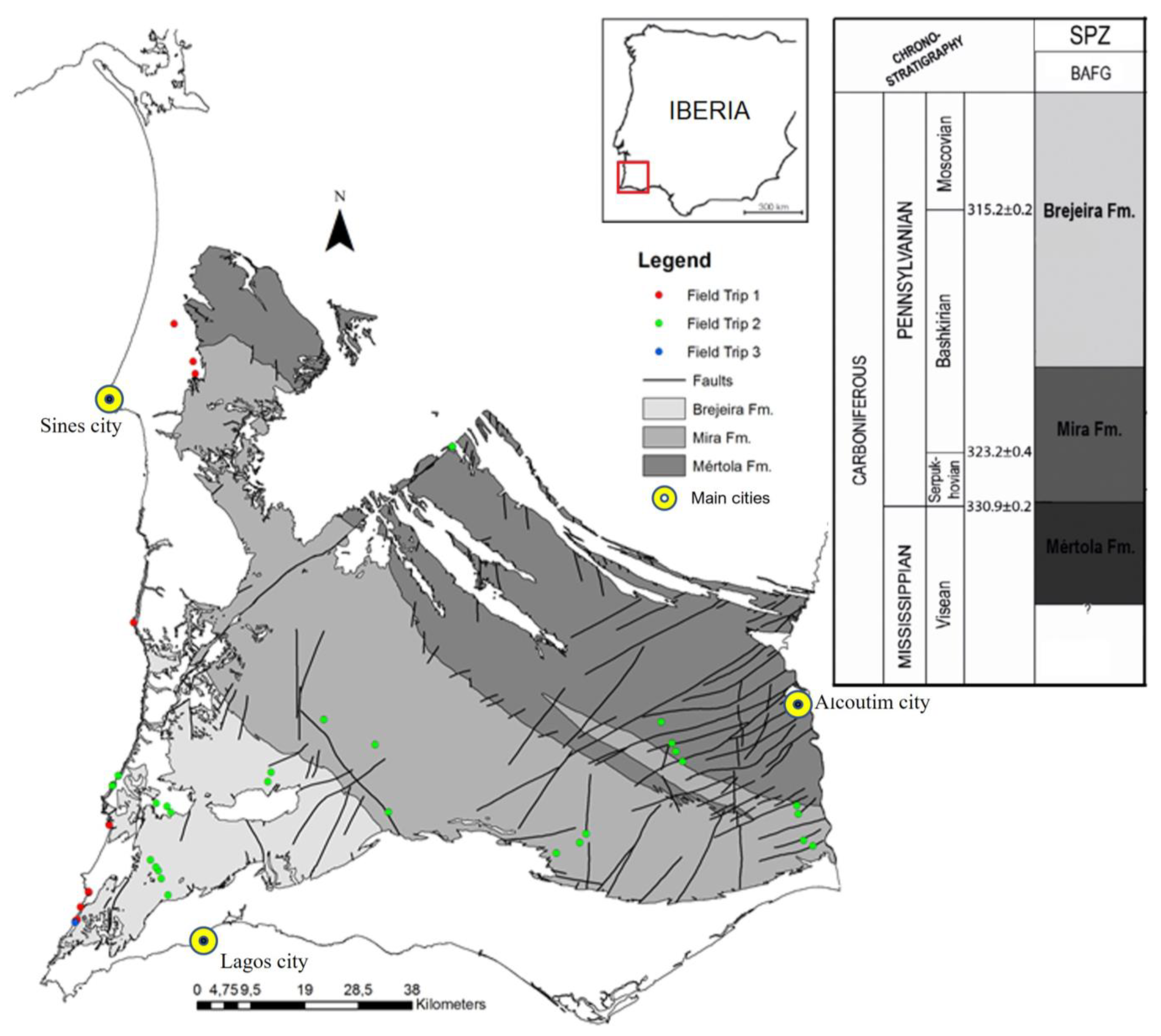
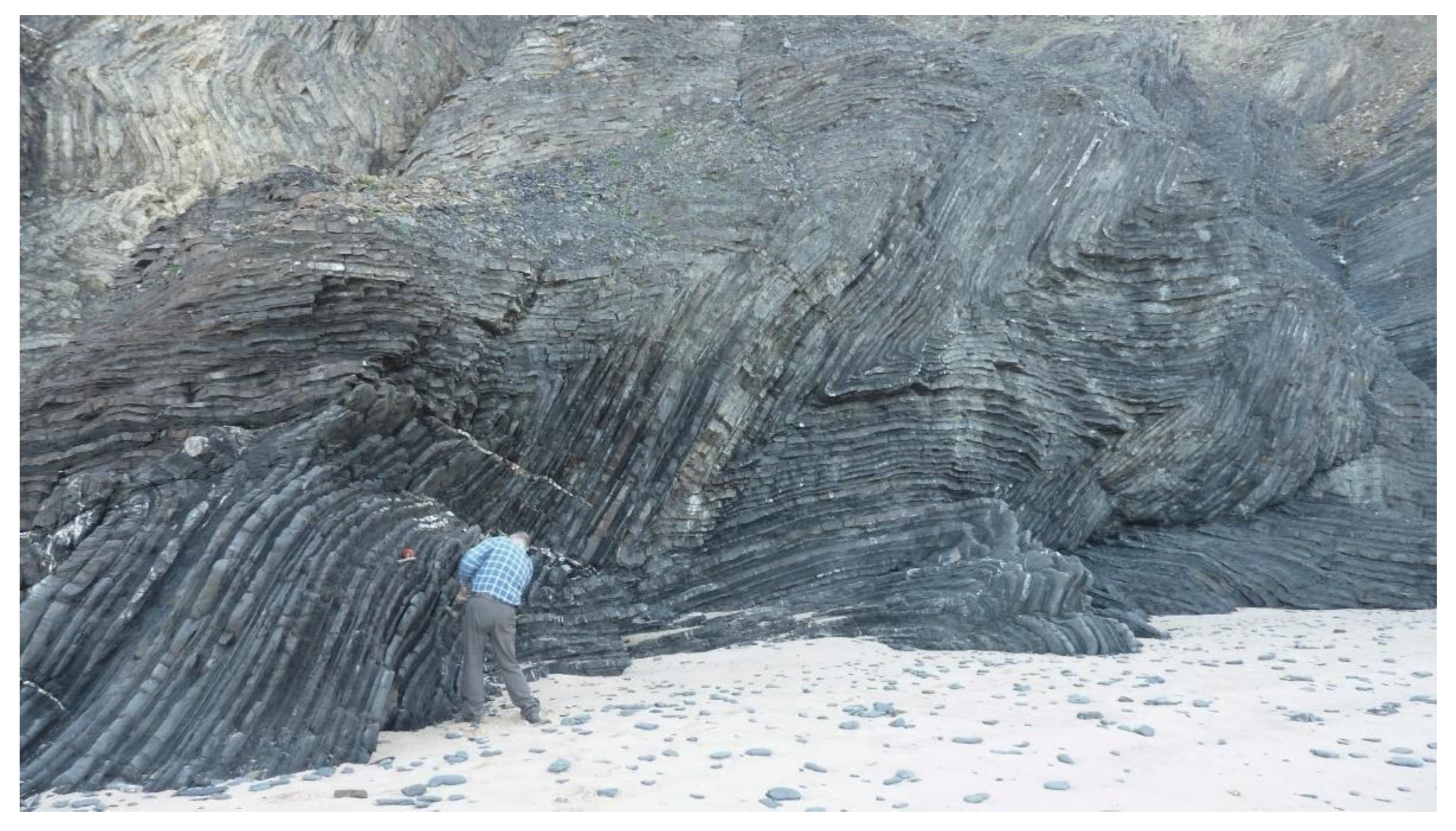
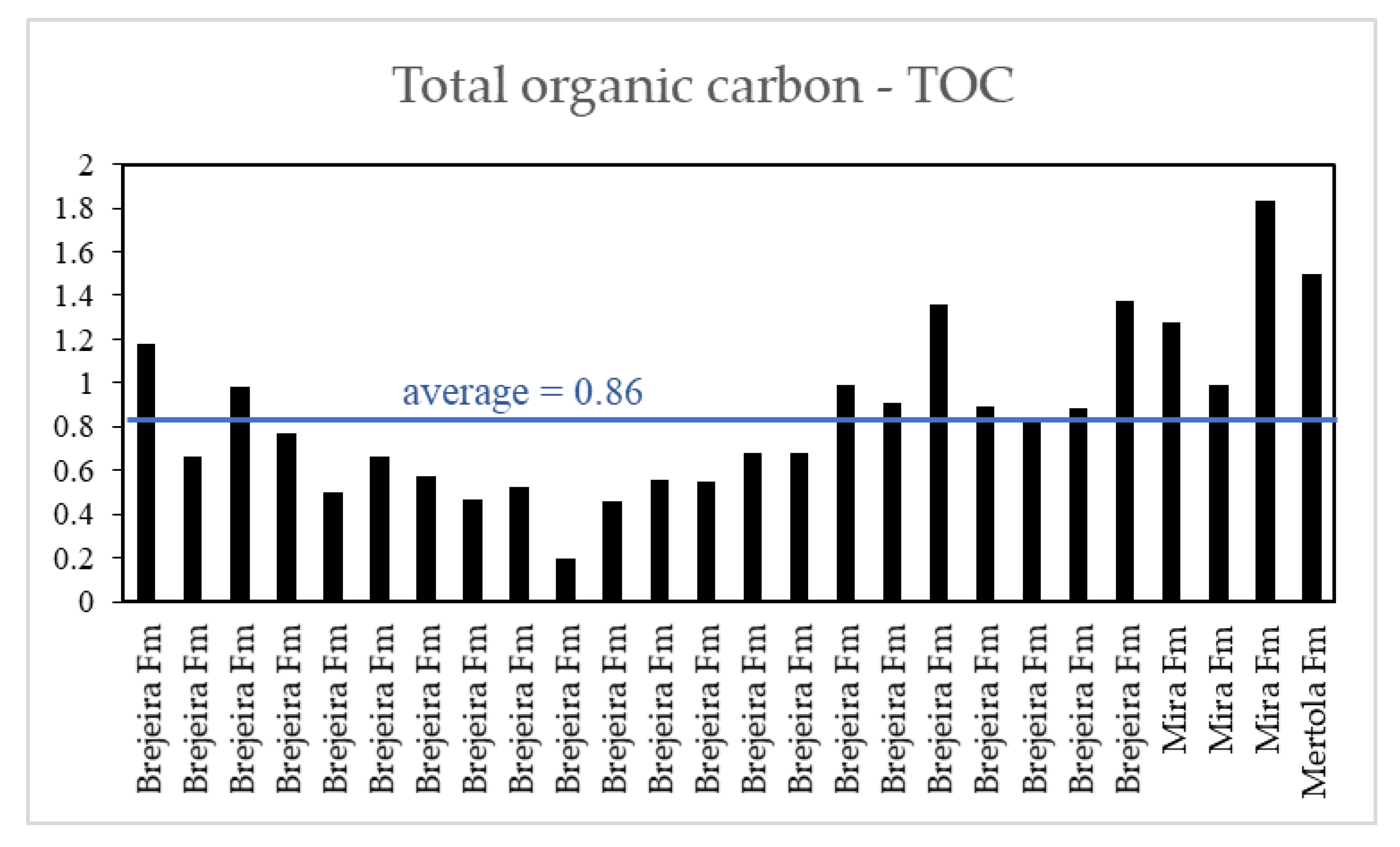
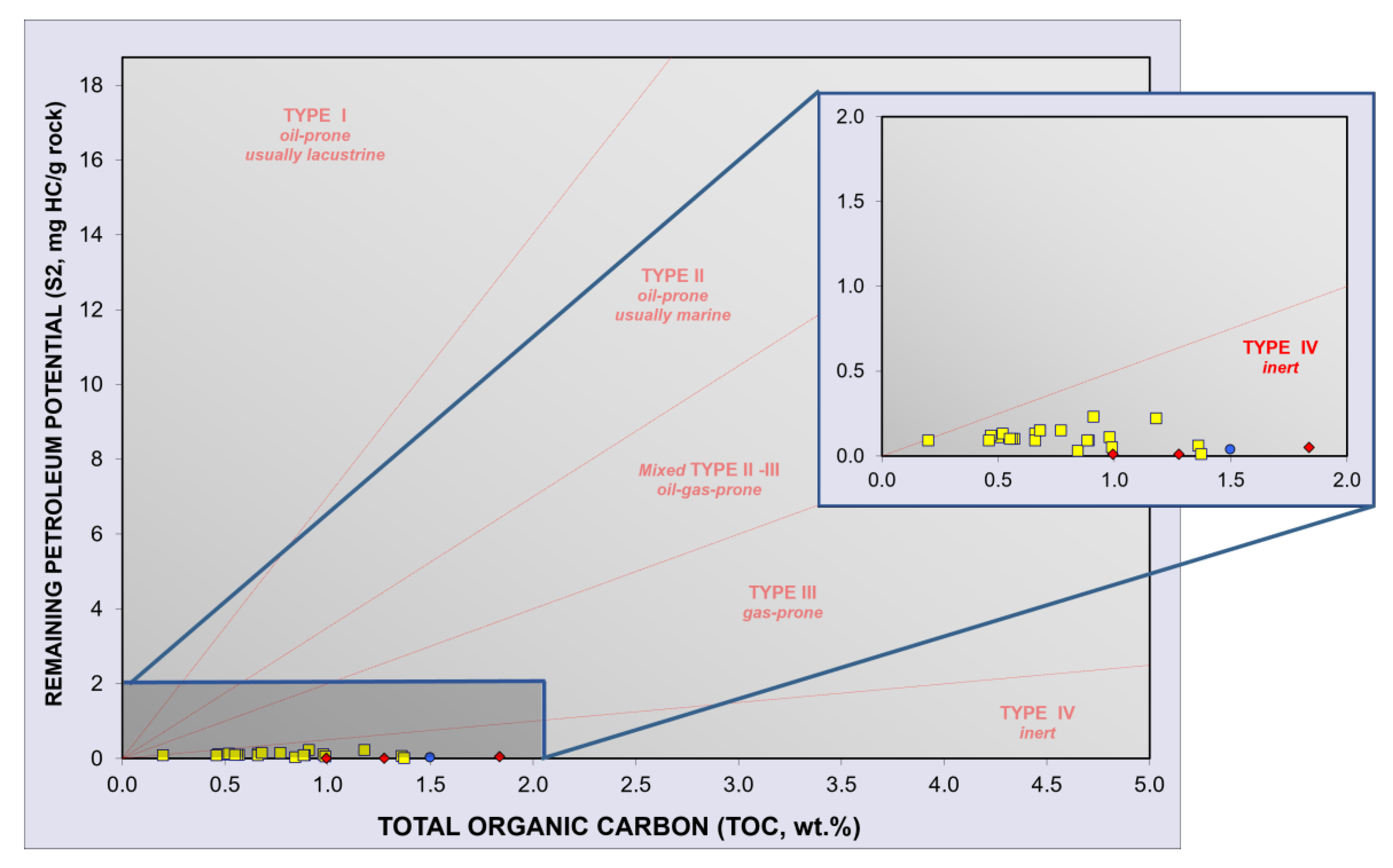
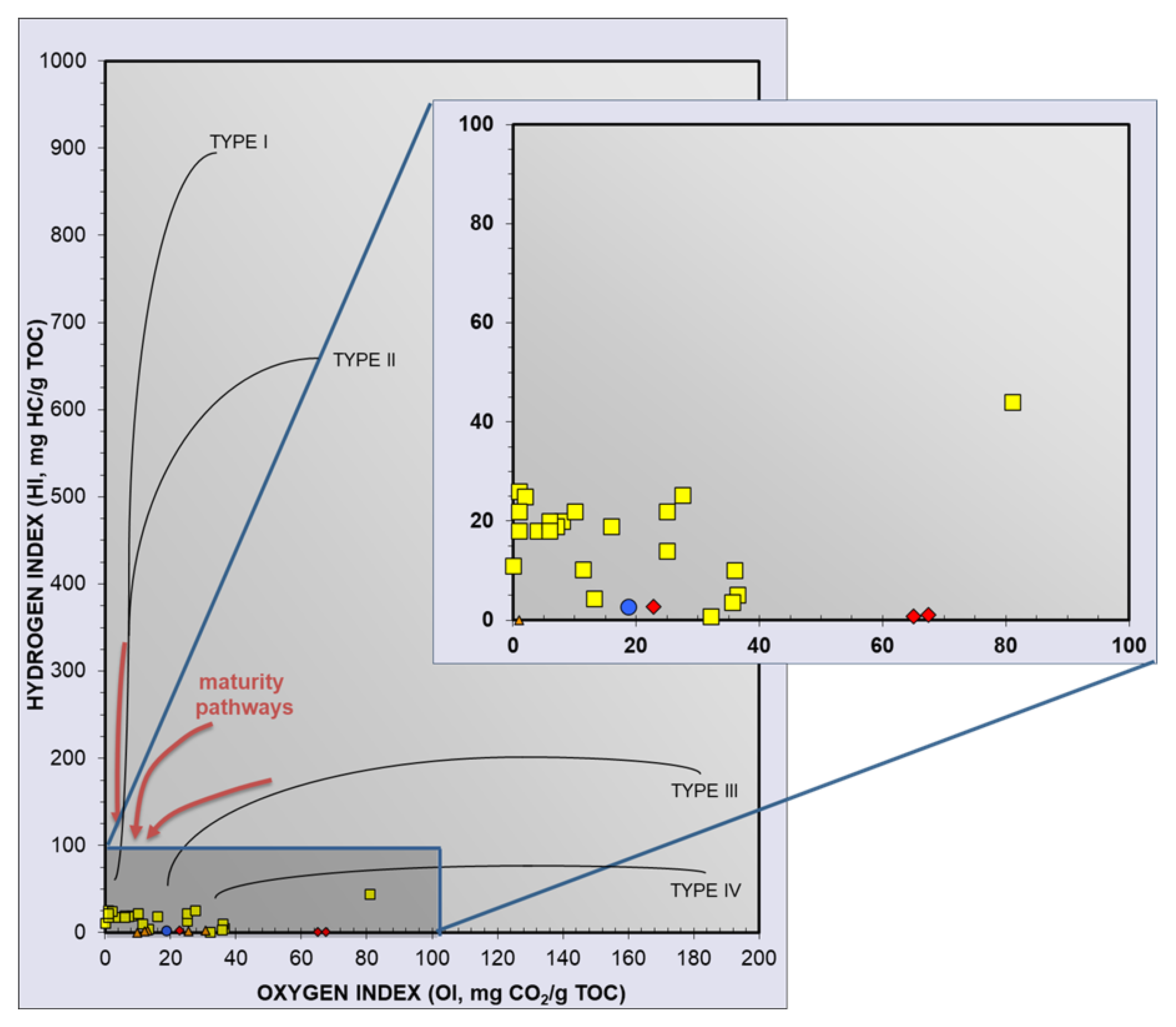
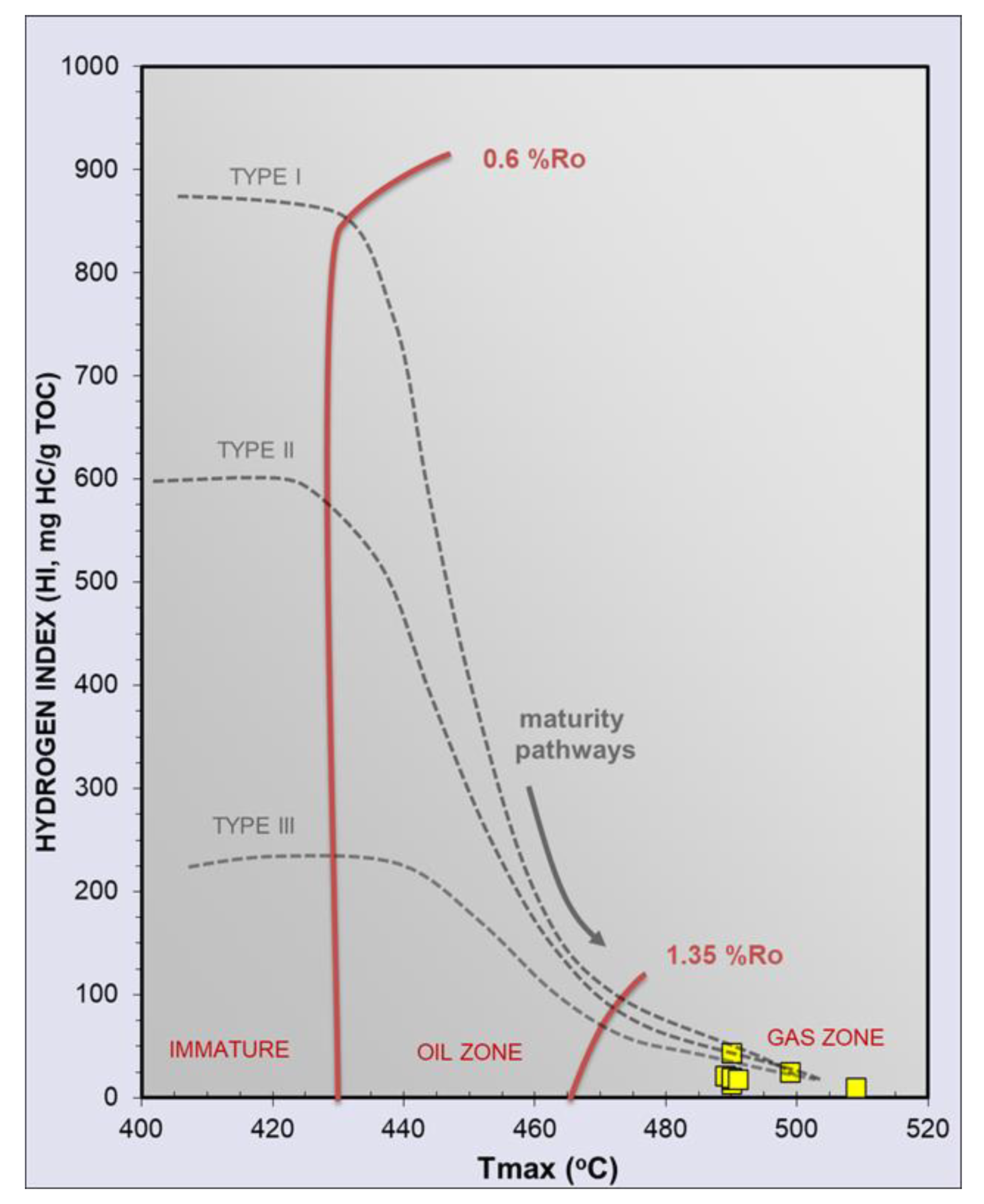
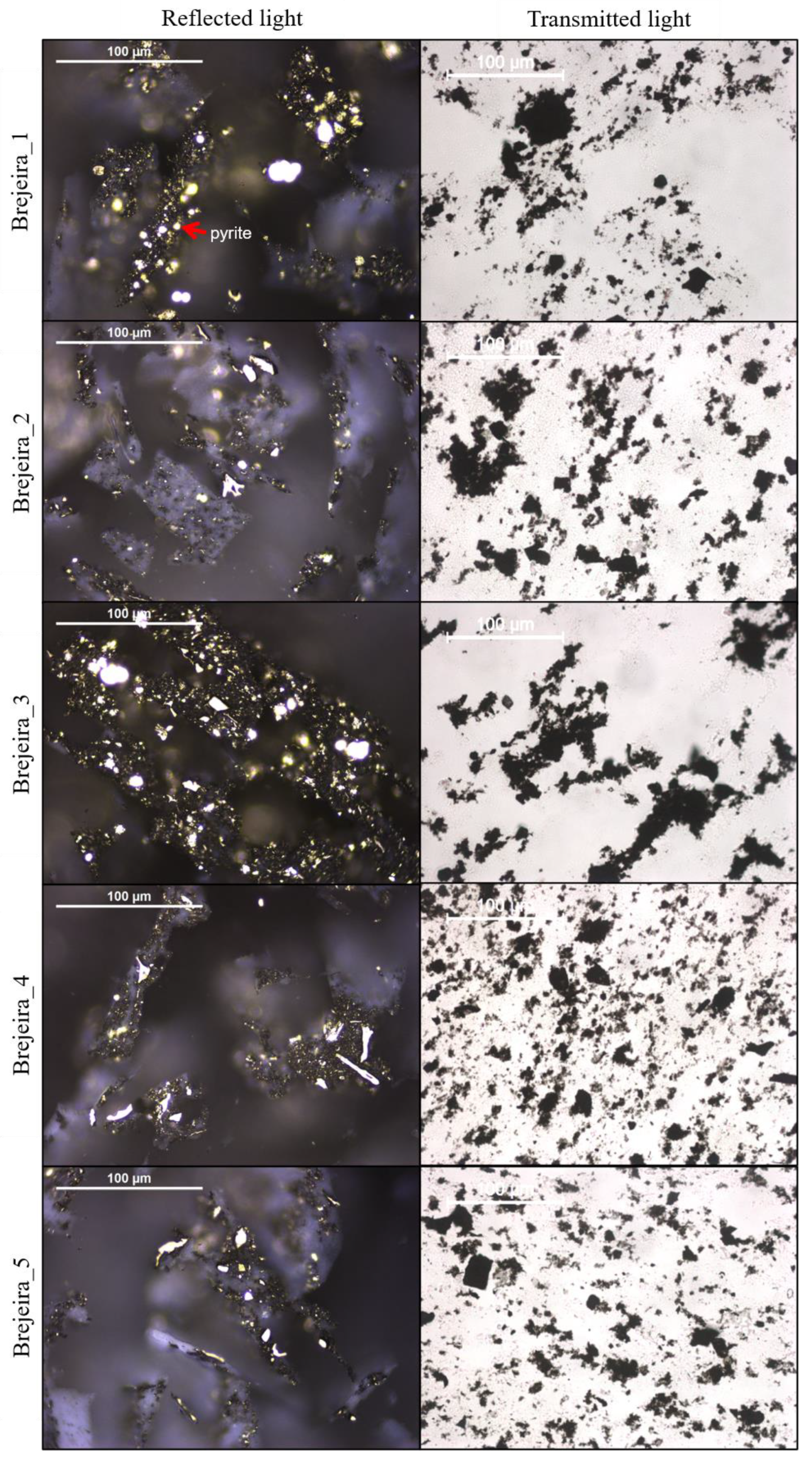
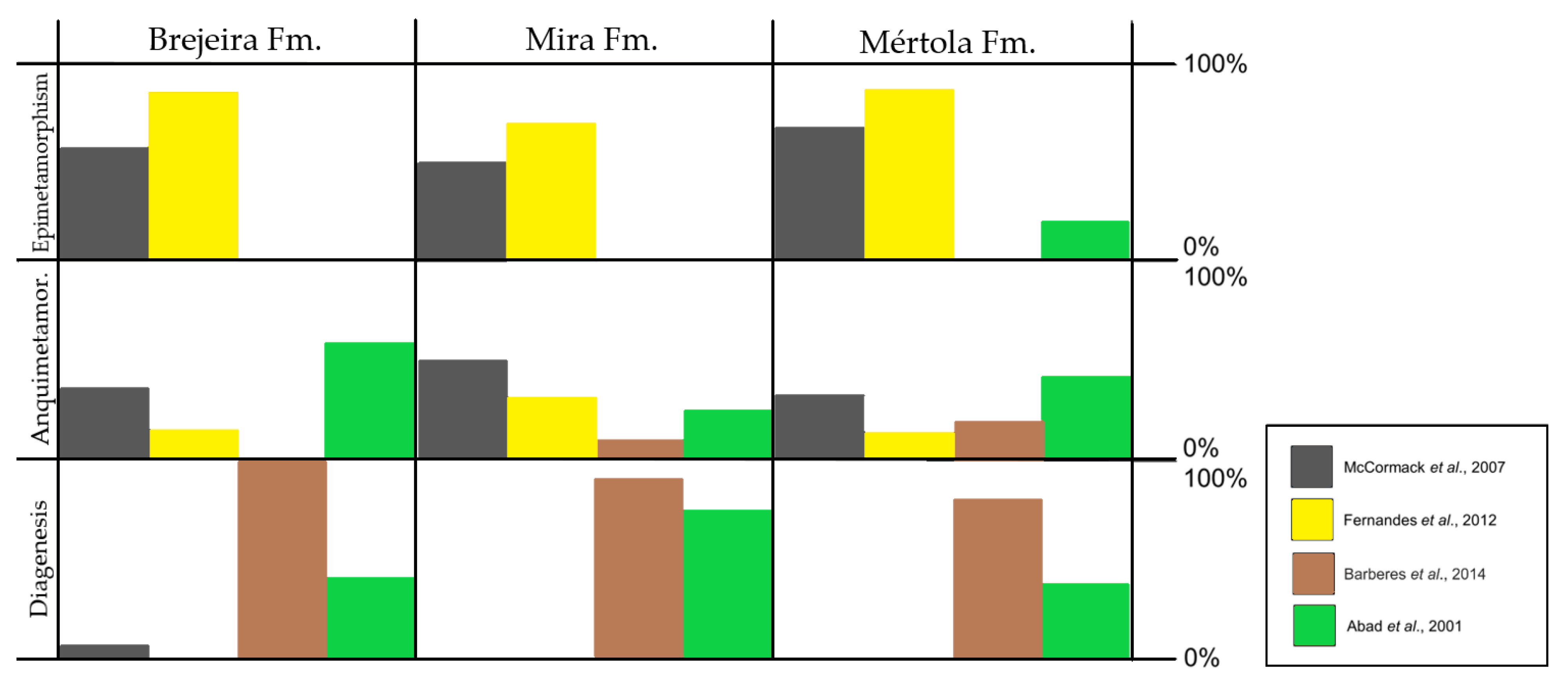
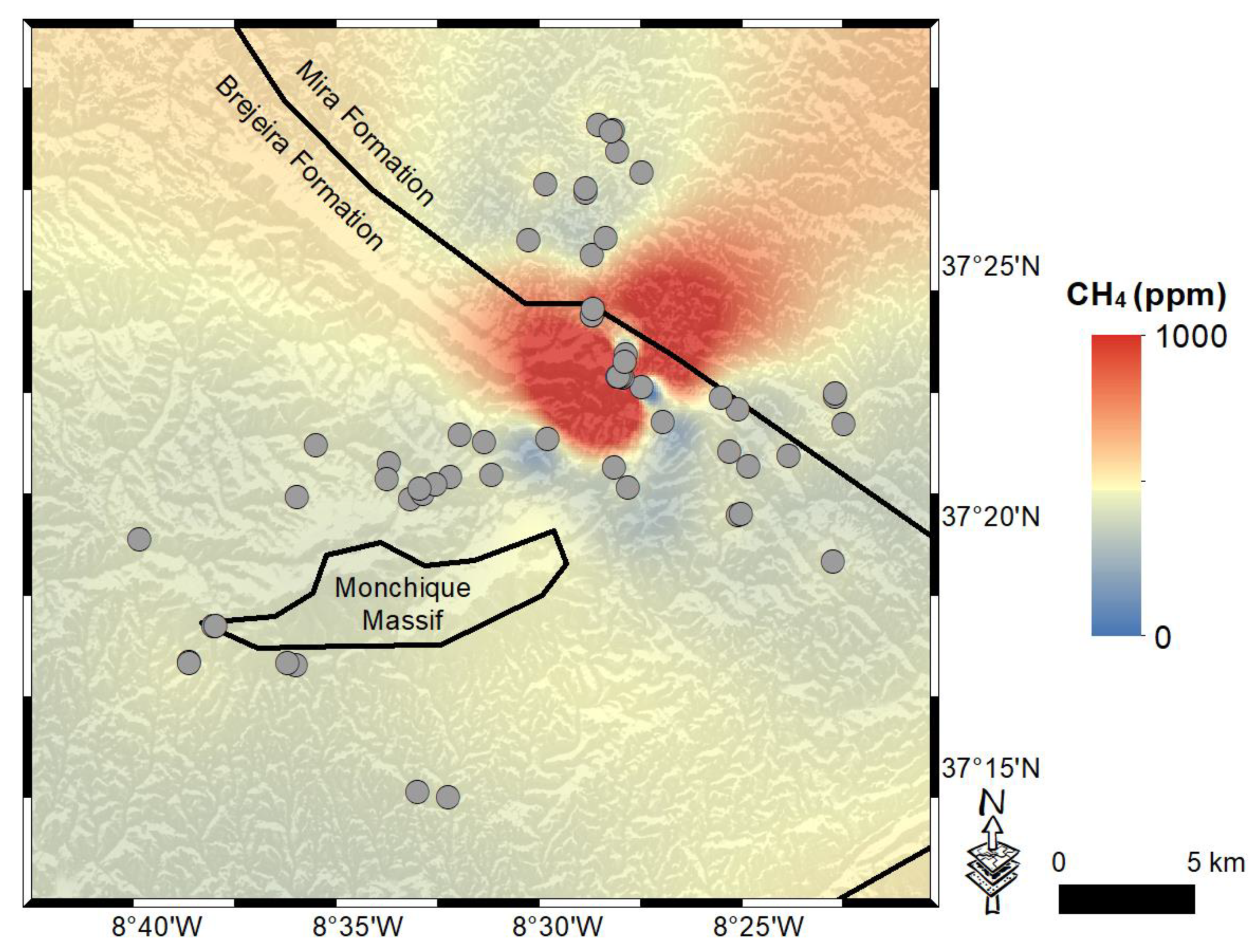
| Lithostratigraphy | TOC | S1 | S2 | S3 | Tmax | HI | OI | Performer |
|---|---|---|---|---|---|---|---|---|
| wt% | mgHC/gRock | mgCO2/gRock | °C | ngHC/gTOC | mgCO2/gTOC | |||
| Brejeira Fm | 0.66 | 0.02 | 0.09 | 0.17 | 490 | 14 | 25 | PGI |
| Brejeira Fm | 1.18 | 0.04 | 0.22 | 0.19 | 610 | 19 | 16 | PGI |
| Brejeira Fm | 0.66 | 0.03 | 0.13 | 0.05 | 351 | 20 | 8 | PGI |
| Brejeira Fm | 0.98 | 0.03 | 0.11 | 0 | 362 | 11 | 0 | PGI |
| Brejeira Fm | 0.77 | 0.03 | 0.15 | 0.05 | 317 | 19 | 7 | PGI |
| Brejeira Fm | 0.5 | 0.03 | 0.11 | 0.05 | 489 | 22 | 10 | PGI |
| Brejeira Fm | 0.57 | 0.02 | 0.1 | 0.02 | 490 | 18 | 4 | PGI |
| Brejeira Fm | 0.47 | 0.03 | 0.12 | 0 | 330 | 26 | 1 | PGI |
| Brejeira Fm | 0.52 | 0.02 | 0.13 | 0.01 | 386 | 25 | 2 | PGI |
| Brejeira Fm | 0.2 | 0.02 | 0.09 | 0.17 | 490 | 44 | 81 | PGI |
| Brejeira Fm | 0.46 | 0.02 | 0.09 | 0.03 | 490 | 20 | 6 | PGI |
| Brejeira Fm | 0.56 | 0.02 | 0.1 | 0.03 | 491 | 18 | 6 | PGI |
| Brejeira Fm | 0.55 | 0.02 | 0.1 | 0.01 | 335 | 18 | 1 | PGI |
| Brejeira Fm | 0.68 | 0.03 | 0.15 | 0.17 | 390 | 22 | 25 | PGI |
| Brejeira Fm | 0.68 | 0.03 | 0.15 | 0.01 | 364 | 22 | 1 | PGI |
| Brejeira Fm | 0.44 | - | - | - | - | - | - | Weatherford |
| Brejeira Fm | 0.72 | - | - | - | - | - | - | Weatherford |
| Brejeira Fm | 0.75 | - | - | - | - | - | - | Weatherford |
| Brejeira Fm | 0.32 | - | - | - | - | - | - | Weatherford |
| Brejeira Fm | 0.39 | - | - | - | - | - | - | Weatherford |
| Brejeira Fm | 0.68 | - | - | - | - | - | - | Weatherford |
| Brejeira Fm | 0.7 | - | - | - | - | - | - | Weatherford |
| Brejeira Fm | 0.75 | - | - | - | - | - | - | Weatherford |
| Brejeira Fm | 0.81 | - | - | - | - | - | - | Weatherford |
| Brejeira Fm | 0.79 | - | - | - | - | - | - | Weatherford |
| Brejeira Fm | 0.46 | - | - | - | - | - | - | Weatherford |
| Brejeira Fm | 0.67 | - | - | - | - | - | - | Weatherford |
| Brejeira Fm | 0.45 | - | - | - | - | - | - | Weatherford |
| Brejeira Fm | 0.9 | - | - | - | - | - | - | Weatherford |
| Brejeira Fm | 0.52 | - | - | - | - | - | - | Weatherford |
| Brejeira Fm | 0.58 | - | - | - | - | - | - | Weatherford |
| Brejeira Fm | 0.26 | - | - | - | - | - | - | Weatherford |
| Brejeira Fm | 0.989 | 0.04 | 0.05 | 0.36 | 383 | 5.06 | 36.40 | Weatherford |
| Brejeira Fm | 0.91 | 0.04 | 0.23 | 0.25 | 499 | 25.27 | 27.47 | Weatherford |
| Brejeira Fm | 1.361 | 0.11 | 0.06 | 0.18 | 438 | 4.41 | 13.26 | Weatherford |
| Brejeira Fm | 0.889 | 0.12 | 0.09 | 0.32 | 444 | 10.12 | 36.00 | Weatherford |
| Brejeira Fm | 0.842 | 0.06 | 0.03 | 0.3 | 426 | 3.56 | 35.63 | Weatherford |
| Brejeira Fm | 0.884 | 0.06 | 0.09 | 0.1 | 509 | 10.18 | 11.31 | Weatherford |
| Brejeira Fm | 1.373 | 0.04 | 0.01 | 0.44 | 424 | 0.73 | 32.05 | Weatherford |
| Mira Fm | 1.276 | 0.02 | 0.01 | 0.83 | 424 | 0.78 | 65.05 | Weatherford |
| Mira Fm | 0.23 | - | - | - | - | - | - | Weatherford |
| Mira Fm | 0.79 | - | - | - | - | - | - | Weatherford |
| Mira Fm | 0.95 | - | - | - | - | - | - | Weatherford |
| Mira Fm | 0.79 | - | - | - | - | - | - | Weatherford |
| Mira Fm | 0.52 | - | - | - | - | - | - | Weatherford |
| Mira Fm | 0.85 | - | - | - | - | - | - | Weatherford |
| Mira Fm | 0.993 | 0.01 | 0.01 | 0.67 | 312 | 1.00 | 67.47 | Weatherford |
| Mira Fm | 0.9 | - | - | - | - | - | - | Weatherford |
| Mira Fm | 1.836 | 0.02 | 0.05 | 0.42 | 357 | 2.72 | 22.88 | Weatherford |
| Mertola Fm | 0.66 | - | - | - | - | - | - | Weatherford |
| Mertola Fm | 1.496 | 0.08 | 0.04 | 0.28 | 347 | 2.67 | 18.72 | Weatherford |
| Mertola Fm | 0.73 | - | - | - | - | - | - | Weatherford |
| Mertola Fm | 0.78 | - | - | - | - | - | - | Weatherford |
| Sample | Liptinite (%) | Vitrinite | Inertinite | Solid Bitumen | Liptinite Fluores. | Oil Prone | Gas Prone | Pollen/ Spores | TAI | |||
|---|---|---|---|---|---|---|---|---|---|---|---|---|
| Alginite (%) | AOM (%) | Other (%) | (%) | |||||||||
| Fluomes. | Non Fluores. | |||||||||||
| Brejeira_1 | 0 | 0 | 80 | 0 | 0 | 0 | 20 | 0 | 0 | 80 | absent | 3.7 |
| Brejeira_2 | 0 | 0 | 75 | 0 | trace | 15 | 10 | 0 | 0 | 75 | absent | 3.7 |
| Brejeira_3 | 0 | 0 | 70 | 0 | trace | 15 | 15 | 0 | 0 | 70 | absent | 3.7 |
| Brejeira_4 | 0 | 0 | 80 | 0 | trace | 5 | 15 | 0 | 0 | 80 | sporadic | 3.7 |
| Brejeira_5 | 0 | 0 | 75 | 0 | 0 | 10 | 15 | 0 | 0 | 75 | absent | 3.7 |
| Samples | Brejeira_1 | Brejeira_2 | Brejeira_3 | Brejeira_4 | Brejeira_5 |
|---|---|---|---|---|---|
| Minimum Ro (%) | 1.5 | 1.5 | 1.89 | 1.78 | 2.07 |
| Maximum Ro (%) | 1.78 | 2.51 | 3 | 2.32 | 2.59 |
| Number of points | 10 | 25 | 7 | 5 | 5 |
| Standard deviation | 0.095 | 0.249 | 0.38 | 0.216 | 0.192 |
| Mean Ro value of pyrobitumen (%) | 1.63 | 1.98 | 2.26 | 1.97 | 2.29 |
| VRE value (%) Schoenherr et al. (2007) [20] | 1.78 | 2.12 | 2.38 | 2.11 | 2.42 |
Publisher’s Note: MDPI stays neutral with regard to jurisdictional claims in published maps and institutional affiliations. |
© 2021 by the authors. Licensee MDPI, Basel, Switzerland. This article is an open access article distributed under the terms and conditions of the Creative Commons Attribution (CC BY) license (https://creativecommons.org/licenses/by/4.0/).
Share and Cite
Barberes, G.A.; Pena dos Reis, R.; Pimentel, N.L.; Spigolon, A.L.D.; Fonseca, P.E.; Karcz, P.; Azevedo, M.C.; Barata, M.T. Geochemical Considerations from the Carboniferous Unconventional Petroleum System of SW Iberia. Minerals 2021, 11, 811. https://doi.org/10.3390/min11080811
Barberes GA, Pena dos Reis R, Pimentel NL, Spigolon ALD, Fonseca PE, Karcz P, Azevedo MC, Barata MT. Geochemical Considerations from the Carboniferous Unconventional Petroleum System of SW Iberia. Minerals. 2021; 11(8):811. https://doi.org/10.3390/min11080811
Chicago/Turabian StyleBarberes, Gabriel A., Rui Pena dos Reis, Nuno L. Pimentel, André L. D. Spigolon, Paulo E. Fonseca, Przemysław Karcz, Marco C. Azevedo, and Maria Teresa Barata. 2021. "Geochemical Considerations from the Carboniferous Unconventional Petroleum System of SW Iberia" Minerals 11, no. 8: 811. https://doi.org/10.3390/min11080811
APA StyleBarberes, G. A., Pena dos Reis, R., Pimentel, N. L., Spigolon, A. L. D., Fonseca, P. E., Karcz, P., Azevedo, M. C., & Barata, M. T. (2021). Geochemical Considerations from the Carboniferous Unconventional Petroleum System of SW Iberia. Minerals, 11(8), 811. https://doi.org/10.3390/min11080811






